Posted By Mark March 7, 2013
It’s sporty, it’s fuel injected, it’s green and it’s powered by ethanol. If you are thinking NASCAR™ race cars that’s a good guess but you would be wrong. Because in this case the equipment in question is literally green…as in covered in the well know green and yellow paint of John Deere tractors, combines and lawn equipment.
And unlike the 200 mile-per-hour race cars that trade mileage for speed, the new John Deere ZTrack mower is also efficient.
John Deere recently released their new, ZTrak Z925M, zero-turn, Flex Fuel Commercial Mowers, capable of running on ethanol blends up to E85 (85 percent ethanol, 15 percent gasoline). When you stop to think about it, it makes perfect sense. Ethanol blends are powering nearly every vehicle on the road today with blends of ethanol from 10% to 85%, so it was only a matter of time before we mowed with high octane E85 too.
John Deere tractors and combines have been frequenting the nation’s corn fields for generations as a stalwart contributor to planting and harvesting operations so the ZTrack Flex-Fuel seems…well, logical.
E10 (10% ethanol) has been utilized successfully in small gas engines, boats and mowers for decades so we applaud John Deere’s decision to go green, utilize a homegrown fuel and support rural America by bringing an E85 capable to the market . Be sure to try out the new ZTrak Flex Fuel mower next time you visit your dealer and tell the Corn Growers sent you.
(E10 has been approved for use by all small gas engine manufacturers as well as marine engine manufacturers. Let your mouse d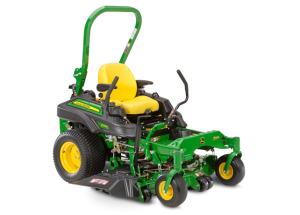 o the walking if you want to know more.)
o the walking if you want to know more.)
Posted By Cathryn September 18, 2012
This guest post comes courtesy of Brian Scott, a farmer featured in NCGA’s Field Notes series and the author of The Farmers Life blog. Scott also agvocates on Twitter as @thefarmerslife.
In this post, Scott offers his personal insight into why the impressive field machinery visible from the road makes modern agriculture possible.
Harvesting Corn Nonstop
Being efficient is important during harvest for many reasons. When conditions are right you want to get crops harvested in a timely manner while those conditions are still in effect. Maximizing productivity can also cut fuel costs and puts less hours on machinery which preserves value when it’s time to sell or trade equipment.

Our combine and grain cart taking a rest at the end of the day.
One way we keep the combine combining is through the use of a grain cart. The cart allows the combine operator to unload grain while harvesting so he doesn’t have to stop to fill a truck. Combines have separate hour meters for the engine and threshing components. You’d be surprised to see how much time a combine spends not harvesting. You have idle time, road travel, moving in and out of tool sheds, and so on.
All this time adds up. If memory serves, the last combine we traded had close to 1000 engine hours and 650 separator hours. So a machine whose sole purpose is to harvest grain spent 35% of its life not harvesting. That’s why we often use a grain cart especially in corn. Corn yield per acre is much higher than soybean’s, which fills the combine frequently. Not so frequently this year, but still much more so than our soybeans. Corn generally yields 3-4 times more grain per acre than beans.
In a normal year I can’t get the combine to the far end of a field and back before it’s full. Without a grain cart that means stopping somewhere in the middle to pull out of the corn and drive over to a truck waiting to be filled. Then I either have to drive back to where I stopped or start a new pass. That’s generally what I do if we don’t have someone around to operate the cart. I’ll harvest as much as I can to fill the combine and cut as many full passes as I can. Then when I get to where I might be waiting for an empty truck to return I go back and get the short rows I couldn’t finish earlier.
Last night I fired up the camera on my tablet I have mounted on the window of the combine cab so you can see the combine unloading on the move.
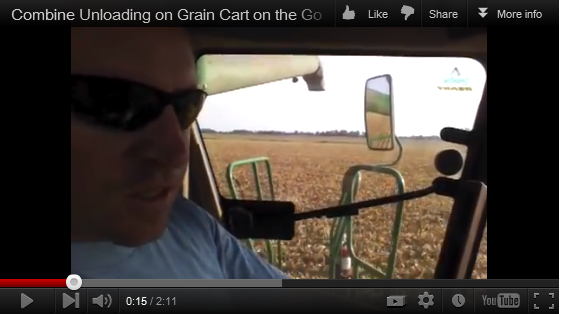
You can see how this process keeps the combine doing what it does best instead of spending half the time driving loaded or empty across the field to get unloaded without harvesting anything. John Deere Machine Sync is a great new technology allowing a combine operator to take control of the tractor pulling the grain cart when it gets close enough. The tractor will link up with the combine and stay a certain distance away. After that the combine operator has the ability to shuttle the cart back and forth in order to fill the cart to capacity. If you’ve ever driven a or filled a grain cart you know with two humans at the controls of two machines you can’t quite get the cart full every time. Another part of this technology benefits a grain cart operator chasing more than one combine. The grain cart can now monitor which combine needs unloaded first and chase that machine down before it gets full. Pretty cool!
Posted By Cindy November 5, 2009
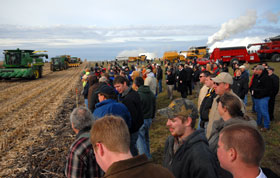 The corn cob harvest was making progress in Emmetsburg, Iowa.
The corn cob harvest was making progress in Emmetsburg, Iowa.
During POET’s Project LIBERTY Field Day, 16 companies showcased equipment to help farmers make the process of harvesting corn cobs and residue quick, easy and profitable. Project LIBERTY is POET’s planned 25 million-gallon-per-year cellulosic ethanol plant in Emmetsburg.
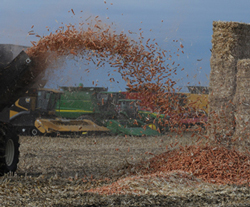 Among the many farmers who turned out to watch the demonstration was Myron Bruhn of Cylinder, Iowa. “I think it’s a good deal for the farmers if they can make ethanol from the cobs,” he said. “Ultimately, if we can make money doing it, it will be able to fly. If we can’t make money on purchasing the equipment and getting paid for the cobs on a two or three year return, there won’t be too many farmers trying it.”
Among the many farmers who turned out to watch the demonstration was Myron Bruhn of Cylinder, Iowa. “I think it’s a good deal for the farmers if they can make ethanol from the cobs,” he said. “Ultimately, if we can make money doing it, it will be able to fly. If we can’t make money on purchasing the equipment and getting paid for the cobs on a two or three year return, there won’t be too many farmers trying it.”
Cobs will be the primary feedstock for the Project LIBERTY plant and agriculture equipment manufacturers are working to ramp up production of cob harvesting equipment. Some farmers may be eligible for federal funding from USDA or the Department of Energy to help purchase the new equipment.
Posted By Chuck July 30, 2009
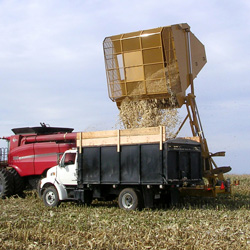 Corn cobs aren’t just for pipes anymore. Now we’re seeing some real interest in utilizing them for a variety of purposes and for farmers that could mean extra income. You might think cellulosic ethanol production first but look at this list of other uses for cobs:
Corn cobs aren’t just for pipes anymore. Now we’re seeing some real interest in utilizing them for a variety of purposes and for farmers that could mean extra income. You might think cellulosic ethanol production first but look at this list of other uses for cobs:
livestock feed supplement for mixed rations, livestock and pet animal bedding, blending cobs with coal to co-generate electricity, gasification to create several types of energy for industrial processes, and other industrial applications including construction materials, abrasives and absorbents
Harvesting corn cobs take some specialized equipment like this new cob harvester from Vermeer. It’s actually a system that tows behind a corn harvesting combine to collect and unload the cobs.
Farmers today are becoming more and more efficient and finding ways to better utilize our natural resources including the ones they grow.
Posted By Cindy February 18, 2009
John Deere may have cut its profit forecast for this year by 20 percent, but the company is still betting big on the nation’s agriculture industry.
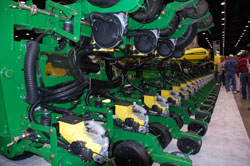 Deere officials said today that they expect the North American agricultural market to be their best this year compared to other areas of the world. During a conference call today, Deere CEO Robert Lane said that demand for large farming machinery has held up well largely due to the financial health of U.S. agriculture.
Deere officials said today that they expect the North American agricultural market to be their best this year compared to other areas of the world. During a conference call today, Deere CEO Robert Lane said that demand for large farming machinery has held up well largely due to the financial health of U.S. agriculture.
So well, in fact, that at last week’s National Farm Machinery Show in Louisville, Deere unveiled the new DB120 - the largest planter in the industry. This bad boy is so big they couldn’t even unfold it all the way in their huge exhibit space!
Rob Rippchen, division marketing manager at John Deere seed in Moline, IL says this 120 foot planter is the next generation planter building off the DB90 introduced five years ago. “This planter will plant somewhere between 90 and 100 acres an hour,” Rob says. “Most growers will remember last spring when it was so wet and one of the easiest ways to improve productivity is to increase your working width.”
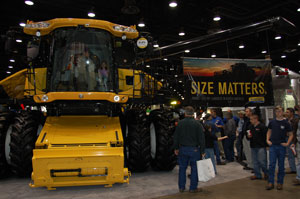 Another company betting big on North American agriculture is New Holland, which had on display at the NFMS what they claim is the largest combine in North America - the new CR9080 with 523 maximum horsepower.
Another company betting big on North American agriculture is New Holland, which had on display at the NFMS what they claim is the largest combine in North America - the new CR9080 with 523 maximum horsepower.
Ed Barry with New Holland, told me that it’s not just horsepower that makes it the biggest, “It’s the largest cab, largest threshing area and largest cleaning area.”
Meanwhile, Case IH is also claiming the biggest combine title with its Axial-Flow 9120 at 483 rated hp. Just for good measure, Farm Industry News gave them both one of their 2008 FinOvation awards.
All will be on display at the Commodity Classic in Grapevine next week - you be the judge!
 o the walking if you want to know more.)
o the walking if you want to know more.)






 The corn cob harvest was making progress in Emmetsburg, Iowa.
The corn cob harvest was making progress in Emmetsburg, Iowa. Among the many farmers who turned out to watch the demonstration was Myron Bruhn of Cylinder, Iowa. “I think it’s a good deal for the farmers if they can make ethanol from the cobs,” he said. “Ultimately, if we can make money doing it, it will be able to fly. If we can’t make money on purchasing the equipment and getting paid for the cobs on a two or three year return, there won’t be too many farmers trying it.”
Among the many farmers who turned out to watch the demonstration was Myron Bruhn of Cylinder, Iowa. “I think it’s a good deal for the farmers if they can make ethanol from the cobs,” he said. “Ultimately, if we can make money doing it, it will be able to fly. If we can’t make money on purchasing the equipment and getting paid for the cobs on a two or three year return, there won’t be too many farmers trying it.” Corn cobs aren’t just for pipes anymore. Now we’re seeing some real interest in utilizing them for a variety of purposes and for farmers that could mean extra income. You might think cellulosic ethanol production first but look at this list of other uses for cobs:
Corn cobs aren’t just for pipes anymore. Now we’re seeing some real interest in utilizing them for a variety of purposes and for farmers that could mean extra income. You might think cellulosic ethanol production first but look at this list of other uses for cobs: Deere officials said today that they expect the North American agricultural market to be their best this year compared to other areas of the world. During a conference call today, Deere CEO Robert Lane said that demand for large farming machinery has held up well largely due to the financial health of U.S. agriculture.
Deere officials said today that they expect the North American agricultural market to be their best this year compared to other areas of the world. During a conference call today, Deere CEO Robert Lane said that demand for large farming machinery has held up well largely due to the financial health of U.S. agriculture. Another company betting big on North American agriculture is
Another company betting big on North American agriculture is